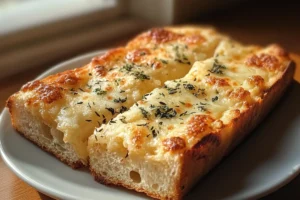Puerto Rican Pernil is one of the most iconic dishes in Puerto Rican cuisine. With its tender, flavorful meat and crispy skin, it has earned a place at the heart of Puerto Rican family gatherings and celebrations. From its rich history to its influence in modern kitchens, Pernil represents the essence of Puerto Rican culture and culinary traditions. Whether you’re cooking it for a holiday feast or simply craving some authentic flavors, learning how to prepare Pernil is a rewarding journey.
In this article, we’ll dive deep into the history of Puerto Rican Pernil, explore its cultural significance, walk you through the essential ingredients, provide tips for marination and cooking, and even offer serving suggestions and modern variations. To get a head start, take a look at the traditional Pernil recipe by The Mom 100 for an easy-to-follow guide, or check out Sense and Edibility’s tips for achieving the perfect crackling skin.
The Historical Roots of Puerto Rican Pernil
Pernil has roots deep in Puerto Rican history, influenced by a mix of Spanish, African, and indigenous culinary practices. It’s a dish that symbolizes more than just food; it reflects the merging of cultures and the resilience of Puerto Rican people.
Historically, pork has been a central protein in Puerto Rican cooking, dating back to the Spanish colonization of the island. The technique of slow-roasting pork was passed down from the Spanish, but the use of spices and flavorings, such as sofrito, adobo, and sazón, comes from African and indigenous influences. The Spanish introduced pigs to Puerto Rico, which led to the development of many pork-based dishes, with Pernil becoming the most beloved of them all.
During holidays like Christmas, Pernil became the star of the feast. The long cooking process of slow roasting allows the flavors of the sofrito and adobo marinade to fully infuse the meat, creating a dish that is not just delicious but also a celebration of Puerto Rican cultural heritage.
For a closer look at how Pernil has evolved, check out Serious Eats’ article on Pernil, where they provide an in-depth explanation of its historical context and preparation.
Ingredients for the Perfect Puerto Rican Pernil

The key to achieving that unforgettable flavor in Puerto Rican Pernil lies in using the right ingredients. Below are the essentials:
- Pork Shoulder or Pork Leg: These cuts are favored for their balance of fat and meat, which ensures a tender roast with a juicy interior. The fat also renders beautifully, contributing to the crispy skin (cuerito).
- Sofrito: A flavor-packed base made from garlic, onions, bell peppers, and cilantro. It’s the foundation of many Puerto Rican dishes, including Pernil, providing depth and fragrance.
- Adobo Seasoning: This versatile seasoning blend includes salt, garlic powder, oregano, and other spices. It’s used liberally to season the pork and create a savory base for the meat.
- Sazón: This seasoning blend is a must-have in Puerto Rican kitchens, adding color and a unique taste to the dish. It typically contains a mixture of spices such as coriander, cumin, and annatto.
- Garlic and Oregano: Fresh garlic and oregano bring out the richness of the pork, enhancing the overall aroma and flavor of the dish.
- Vinegar: Often used in marinades, vinegar adds acidity, which helps tenderize the meat and balance out the richness of the pork.
These ingredients work together to create a Pernil that’s bursting with flavors. To learn more about how each ingredient contributes to the overall dish, visit this traditional Pernil recipe by The Mom 100, which breaks down each component of the dish.
Marinating the Pernil
Marinating Pernil is crucial to infusing the meat with flavor and ensuring that it turns out as tender as possible. The longer you marinate the pork, the more the flavors penetrate the meat, creating a deeply seasoned roast.
Here’s how you can marinate your Pernil to perfection:
- Prepare the Marinade:
- In a large bowl, combine sofrito, adobo seasoning, sazón, minced garlic, oregano, and vinegar. The combination of these ingredients will create a marinade that’s both aromatic and tangy.
- Score the Pork:
- Gently score the surface of the pork with a sharp knife. This allows the marinade to soak into the meat more effectively, ensuring that every bite is packed with flavor.
- Rub the Marinade:
- Generously rub the marinade into the pork, making sure it gets into the scored areas and covers the entire surface.
- Marinate for at Least 8 Hours:
- For the best results, marinate the pork overnight. If time is short, aim for at least 8 hours to give the flavors enough time to meld together.
This marination process is key to creating a flavorful Pernil, and it’s essential that you don’t skip it. You can read about more tips on marinating and cooking Pernil in Sense and Edibility’s cooking guide.
Cooking Techniques for the Best Pernil

Slow-roasting is the traditional cooking method for Pernil, and it’s what gives the pork its rich flavor and melt-in-your-mouth tenderness. The long cooking process also allows the fat to render and the skin to crisp up perfectly.
Here’s how you can cook your Pernil to perfection:
-
Preheat Your Oven:
- Set your oven to 300°F (150°C). The low and slow roast allows the meat to cook evenly, breaking down the fat and collagen without drying out the pork.
-
Place the Pork in a Roasting Pan:
- Transfer the marinated pork to a roasting pan, fat side up. This positioning allows the fat to render while keeping the meat juicy.
-
Roast Slowly:
- Roast the Pernil for about 4-6 hours, depending on the size of the pork. The low temperature ensures the meat becomes tender without overcooking.
-
Crisp the Skin:
- For that irresistible cuerito, increase the oven temperature to 400°F (200°C) for the last 30 minutes of roasting. This will bubble up the skin, giving it a perfect crispiness.
Remember, the key to a great Pernil is patience. Allow the pork to roast slowly and resist the urge to rush the process. If you’re looking for more insights on achieving that perfect crisp, check out Serious Eats’ guide on Pernil.
Serving Puerto Rican Pernil
Once your Pernil is perfectly roasted, it’s time to serve. Traditionally, Pernil is enjoyed with a variety of classic Puerto Rican side dishes:
- Arroz con Gandules: A flavorful rice dish made with pigeon peas, cooked with sofrito and seasoned with sazón. It’s a hearty and savory side that pairs wonderfully with the rich pork.
- Pasteles: A Puerto Rican version of tamales, filled with seasoned meat and wrapped in banana leaves. These are a festive accompaniment to Pernil during holiday meals.
- Tostones: Fried green plantains that are crispy and slightly salty. Their texture provides a perfect contrast to the tender Pernil.
If you want to get creative, Pernil can also be served with mashed potatoes, salads, or even used in sandwiches. Its versatility makes it a dish that can be enjoyed in countless ways.
Print
Puerto Rican Pernil
- Total Time: 13 hours
- Yield: 10 servings 1x
Description
A flavorful Puerto Rican slow-roasted pork shoulder, marinated with garlic, oregano, adobo, and sazón, creating tender meat and crispy skin.
Ingredients
- 1 bone-in pork shoulder (8–10 lbs)
- 1/4 cup sofrito
- 2 tbsp adobo seasoning
- 1 tbsp sazón
- 6 cloves garlic, minced
- 2 tsp dried oregano
- 1/4 cup vinegar
- 2 tbsp olive oil
- Salt and pepper to taste
Instructions
- Score the pork shoulder with a sharp knife, creating deep cuts into the skin and fat.
- In a bowl, mix sofrito, adobo, sazón, garlic, oregano, vinegar, olive oil, salt, and pepper to create the marinade.
- Rub the marinade generously all over the pork, ensuring it gets into the cuts. Cover and refrigerate overnight or at least 8 hours.
- Preheat oven to 300°F (150°C).
- Place the pork shoulder in a roasting pan, fat side up. Cover with foil and roast for 4-6 hours, or until the meat is tender.
- Increase oven temperature to 400°F (200°C) and roast uncovered for an additional 30 minutes to crisp the skin.
- Remove from oven, let rest for 20 minutes, then slice and serve.
Notes
For extra crispy skin, use a broiler for the last few minutes of cooking. Serve with arroz con gandules or tostones for a traditional Puerto Rican meal.
- Prep Time: 8 hours
- Cook Time: 5 hours
- Category: Main Course
- Method: Roasting
- Cuisine: Puerto Rican
Nutrition
- Serving Size: 1 portion
- Calories: 480
- Sugar: 0g
- Sodium: 850mg
- Fat: 35g
- Saturated Fat: 12g
- Unsaturated Fat: 18g
- Trans Fat: 0g
- Carbohydrates: 2g
- Fiber: 0g
- Protein: 38g
- Cholesterol: 120mg
Keywords: pernil, Puerto Rican pork, slow-roasted pork, crispy pork shoulder

